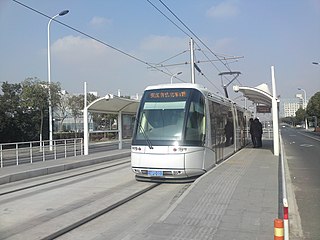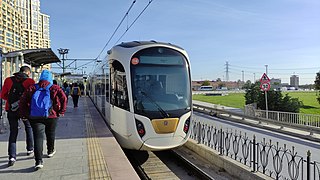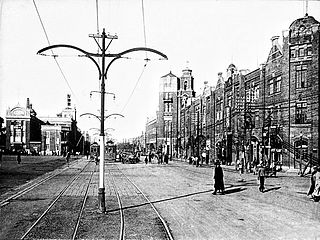
A tram is a type of urban rail transit consisting of either individual railcars or self-propelled multiple unit trains that run on tramway tracks on urban public streets; some include segments on segregated right-of-way. The tramlines or tram networks operated as public transport are called tramways or simply trams/streetcars. Because of their close similarities, trams are commonly included in the wider term light rail, which also includes systems separated from other traffic.

Tianjin is a direct-administered municipality in Northern China on the shore of the Bohai Sea. It is one of the nine national central cities, with a total population of 13,866,009 inhabitants at the time of the 2020 Chinese census. Its metropolitan area, which is made up of 12 central districts, was home to 11,165,706 inhabitants and is also the world's 29th-largest agglomeration and 11th-most populous city proper.

Hong Kong Tramways (HKT) is a 3 ft 6 in narrow-gauge tram system in Hong Kong. Owned and operated by RATP Dev, the tramway runs on Hong Kong Island between Kennedy Town and Shau Kei Wan, with a branch circulating through Happy Valley.

The National Company of Light Railways was a state-owned transportation provider which comprised a system of narrow-gauge tramways or local railways in Belgium, which covered the whole country, including the countryside, and had a greater route length than the mainline railway system. They were 1,000 mmmetre gauge and included electrified city lines and rural lines using steam locomotives and diesel railcars; half the system was electrified.

The Tianjin Metro or Tianjin Rail Transit is the rapid transit system in the city of Tianjin, which was the second city in mainland China after Beijing to operate a subway system. First opened in 1984, the system currently has 11 operating lines and 222 stations spanning 301 km (187.0 mi).
Transport in Tianjin consists of an extensive network of roads and railways and a major airport. Bicycle is a major means of transport in daily use of the city.

Translohr is a rubber-tyred tramway system, originally developed by Lohr Industrie of France and now run by a consortium of Alstom Transport and Fonds stratégique d'investissement (FSI) as newTL, which took over from Lohr in 2012. It is used in Paris and Clermont-Ferrand, France; Medellín, Colombia; and Venice-Mestre and Padua in Italy. In June 2012, Alstom Group and the Strategic Investment Fund acquired Translohr for €35 million.
Trams in Asia were well established at the start of the 20th century, but started to decline in use in the 1930s. By the 1960s, the majority of systems had been closed down. Extensive legacy tramways still exist in Japan. Recently, more modern systems have been built in China.

Although tram and Heritage streetcar systems date to the late 19th and early 20th centuries, many old systems were closed during the mid-20th century because of the advent of automobile travel. This was especially the case in North America, but postwar reductions and shutdowns also occurred on British, French and other Western European urban rail networks. However, traditional tramway systems survived, and eventually even began to thrive from the late 20th century onward, some eventually operating as much as when they were first built over a century ago. Their numbers have been augmented by modern tramway or light rail systems in cities which had discarded this form of transport.

TEDA Modern Guided Rail Tram was a Translohr Light Rail line in Tianjin Economic-Technological Development Area (TEDA). It was a modern, high-speed rubber-tyred tram line, the first in both China and Asia. The line was considered as part of the Tianjin Metro system. It was run by Tianjin Binhai Mass Transit Development Co., Ltd, which has been a subsidiary of Tianjin Rail Transit Group Corporation since 2017.

A rubber-tyred tram is a development of the guided bus in which a vehicle is guided by a fixed rail in the road surface and draws current from overhead electric wires.

Zhangjiang Tram was a tram network operating in Shanghai that utilised a Translohr system. Shanghai originally had a steel wheeled electric tramway network in its urban center. Routes expanded gradually and reached largest extent in 1925 with 328 tramcars; this tram system shut down in 1975. Tram service returned to Shanghai with the opening of a rubber tired Translohr line in the suburban Zhangjiang Hi-Tech Park in 2010. It is the second rubber-tired tram system in both China and Asia, the first being TEDA tram in Tianjin.

Hong Kong is an important port in the Far East and has relied on entrepôt trade to survive its economy for more than a century.

The Istanbul Tram is a modern tram system on the European side of Istanbul. The first section, the T1 opened in 1992, followed by the T2, which opened in 2006. In 2011, the T1 and T2 merged, with the line retaining the T1 name. The T4, T5 and the T6 lines followed, opening in 2007, 2021 and 2024 respectively.
First generation trams in Shanghai began operating in 1908 using a steel wheeled electric system until the last was closed in December 1, 1975. The last operating tram line in Shanghai was No. 3, which ran from Hongkou Park to Jiangwan Wujiaochang. It was dismantled in 1975, and replaced by the 93 bus. In the early days of operation, tram cars were partitioned to provide first- and second-class seating. Some trams, principally for the Chinese workers, were designated as third-class.

Hong Kong's rail network mainly comprises public transport trains operated by the MTR Corporation Limited (MTRC). The MTRC operates the metro network of the territory, the commuter rail network connecting the northeastern, northwestern and southwestern New Territories to the urban areas, and a light rail network in northwestern New Territories. The operations of the territory's two leading railway companies, MTRC and the Kowloon-Canton Railway Corporation (KCRC), were merged in 2007 on grounds of economies of scale and cost effectiveness. The Hong Kong Government has an explicit stated transport policy of using railways as its transport backbone.

Shenyang, a major industrial city on the Hun River in northeast China has returned its tramway as a modern tram system. Shenyang once had a standard steel wheeled tramway network. Unlike other Chinese towns & cities, Shenyang's tram system was not opened directly as an electric tram. The tram service was completely stopped in 1973. On 15 August, 2013 Shenyang opened a modern tram system in Hunnan New District south of central Shenyang.

Several cities in China had tram systems during the 20th century; however, by the end of the century, only Dalian and Changchun remained extant. However the 21st century has seen a resurgence in tram transport systems as China attempts to combat with urban traffic congestion and pollution.
Trams in Athens have existed in two separate generations, the first from 1882 to 1960, and the second since 2004. There were no trams at all in Athens between 1960 and 2004, though the separate Piraeus-Perama light railway remained in operation between nearby Perama and Piraeus until 1977.
The Rosario Tramway was a planned mass transit tramway network in Rosario, Argentina. Nevertheless, the project never surpassed the bidding process stages. The project was assessed by Ferrocarrils de la Generalitat Valenciana and was largely inspired by the network the company runs in Valencia, though at one point a metro system was envisioned. The municipal and provincial governments undertaken discussions with the Industrial and Commercial Bank of China for financing the project, as well as Siemens to provide the rolling stock. Once the project was completed, it would be the first time trams have run in the city on a mass scale since the closure of the city's tramway network in 1963, which had reached a maximum extension of 192 km.















